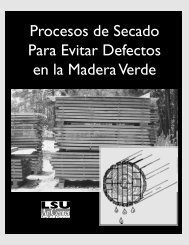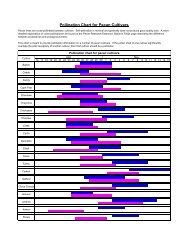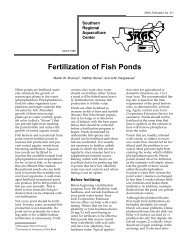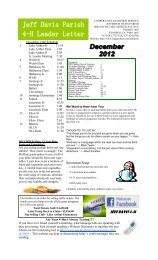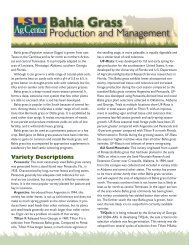Crawfish Trap Design and Construction - SRAC Fact Sheets
Crawfish Trap Design and Construction - SRAC Fact Sheets
Crawfish Trap Design and Construction - SRAC Fact Sheets
Create successful ePaper yourself
Turn your PDF publications into a flip-book with our unique Google optimized e-Paper software.
Pyramid trap construction<br />
As noted above, a pyramid trap usually<br />
has a collar at the top to prevent<br />
escape <strong>and</strong> allow it to be lifted more<br />
easily. Molded trap collars can be<br />
purchased from trap manufacturers.<br />
These pieces have a flared bottom<br />
edge <strong>and</strong> a lip in one side of the top<br />
edge to make the trap easy to grab.<br />
<strong>Trap</strong> collars also can be made with<br />
thin-wall plastic PVC pipe that is 6<br />
inches (15 cm) in diameter <strong>and</strong> cut<br />
into 5-inch (13-cm) pieces. Heat the<br />
top edge of the pipe until the plastic<br />
is softened, then bend one side over<br />
to form a h<strong>and</strong>le. The bottom edge<br />
should be heated <strong>and</strong> then flared outward<br />
somewhat to match the angle of<br />
the top of the trap.<br />
Step 1<br />
Cut a piece of vinyl-coated, squaremesh<br />
wire that is 52 inches (132 cm)<br />
long <strong>and</strong> 24 inches (61 cm) wide (Fig.<br />
8a).<br />
Step 2<br />
Fold the wire in half <strong>and</strong> connect the<br />
sides with rings every 1.5 inches (4<br />
cm). Stop 5 inches (13 cm) from one<br />
end <strong>and</strong> fold in the corner to start<br />
what will eventually become the<br />
third funnel entrance (see below).<br />
Add a few more rings, leaving the last<br />
2 inches (5 cm) of the corner open.<br />
Step 3<br />
Lay the cylinder on its side with the<br />
initial seam facing upward. Close one<br />
of the open ends with a vertical seam,<br />
leaving the corners open to form funnels<br />
(Fig. 8b). At this point, the usual<br />
practice is to place the collar/h<strong>and</strong>le<br />
loosely within the trap before closing<br />
it completely (not pictured in photos).<br />
Close the open end of the trap with a<br />
perpendicular seam. Note: This seam<br />
should be horizontal, while the seam<br />
on the opposite side remains vertical<br />
(Fig. 8c). Leave one corner open for a<br />
third funnel. The other corner will be<br />
trimmed to serve as the throat of the<br />
trap.<br />
Step 4<br />
Use a long-necked bottle or wooden<br />
spindle to form the three funnel entrances<br />
of the trap. In one continuous<br />
motion, push the bottle into an open<br />
Figures 8a-d. The typical process of forming a pyramid trap from a length of squarewire<br />
mesh. For illustrative purposes, the wire has been pre-bent to show where funnels<br />
will be formed <strong>and</strong> pre-cut where the collar will be attached to the throat.<br />
corner <strong>and</strong> extend the funnel about 6<br />
inches (15 cm) into the trap. Funnels<br />
should be angled upward at approximately<br />
45 to 50 degrees. The holes<br />
should be large enough for a large<br />
crawfish to enter. Trim if needed.<br />
(a)<br />
(c)<br />
Step 5<br />
Gently flex <strong>and</strong> bend the wire so that<br />
the three corners with funnels lie<br />
flat on the bottom (Fig. 8d). A slight<br />
crease can be bent into the wire along<br />
the bottom edge of the pyramid. If<br />
left with a rounded bottom, the trap<br />
will easily tip over. The top of the<br />
pyramid can now be cut to fit the<br />
plastic collar. The hole should be cut<br />
slightly smaller than the diameter<br />
of the collar. Cut several squares of<br />
mesh to allow the collar to squeeze<br />
up into the hole (Fig. 9). Use rings to<br />
attach the wire to the outside of the<br />
h<strong>and</strong>le every 1 to 2 inches (2.5 to 5<br />
cm) around the trap.<br />
(b)<br />
(d)<br />
Figure 9. The collar should be placed<br />
within the trap before the third seam is<br />
closed, then pulled into position in the<br />
throat <strong>and</strong> secured with metal rings. Note<br />
the lip at the top of the collar to facilitate<br />
h<strong>and</strong>ling <strong>and</strong> dumping.<br />
Step 6 (Optional)<br />
For stability, attach a rod that is 25<br />
inches (64 cm) long <strong>and</strong> 5 ⁄8 inch (1.6<br />
cm) in diameter to the plastic h<strong>and</strong>le<br />
using several rings through the wire<br />
<strong>and</strong> the plastic top. A 3 ⁄4-inch (1.9-










